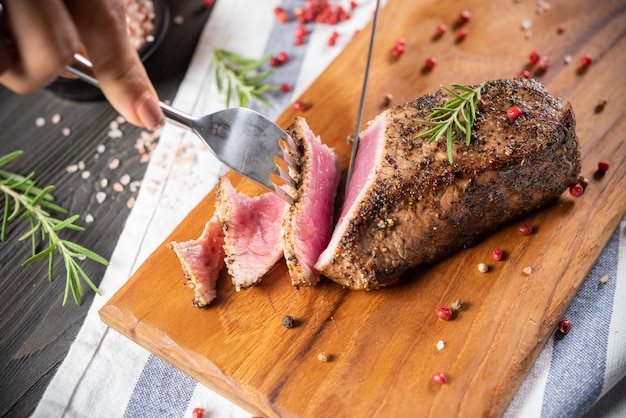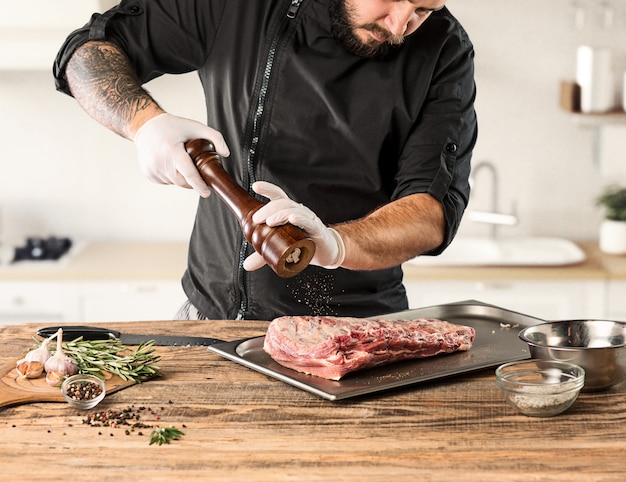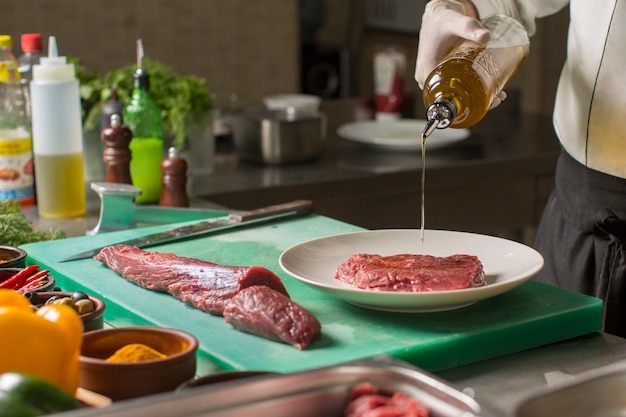(Part 1) The Basics: Steak Anatomy and Choosing the Right Cut

Understanding the Cuts
Let’s start with the foundation – understanding the different cuts of beef. Just like each ingredient in a dish contributes a unique flavour, each cut of steak has its own character, texture, and best application. Here's a breakdown of some of the most popular steak cuts: Rib-Eye: This is the king of steaks, known for its luxurious marbling, which gives it a buttery, rich flavour and tenderness. It’s a true crowd-pleaser and works beautifully for grilling or pan-frying. Sirloin: A leaner cut compared to the rib-eye, sirloin still boasts good flavour and a slightly firmer texture. It’s a versatile cut that’s ideal for grilling, roasting, or pan-frying. new york strip: A close relative of the sirloin, the New York strip is a bit thicker and boasts a more pronounced flavour. It’s perfect for grilling or pan-frying and will hold its shape well during cooking. filet mignon: This is the tenderloin, the most tender cut of beef. It’s lean, delicate, and melts in your mouth. It’s best suited for grilling or pan-frying, as it’s not as thick as other cuts and can be prone to overcooking. flank steak: A lean, flavourful cut known for its distinct grain, flank steak is perfect for marinating and grilling. It’s often sliced thin after cooking, making it ideal for tacos or stir-fries.Choosing Your Steak
Now that you've got a grip on the different cuts, it's time to head to the butcher shop. When choosing your steak, look for a piece that’s a vibrant, deep red colour with a good amount of marbling – the fat running through the meat. Marbling isn't just about aesthetics; it's what gives the steak its juicy flavour and tenderness. Don’t hesitate to ask the butcher for advice, they’re usually brimming with helpful tips and can guide you to the perfect cut for your needs.(Part 2) Prep Work: The Foundation of a Great Steak

1. Seasoning is Key
Seasoning is the first step to unlocking the full potential of your steak. A simple salt and pepper is always a winner, but I like to get a bit creative sometimes. I’ll often add a pinch of smoked paprika for a touch of smokiness or a whisper of garlic powder for a subtle umami boost.Here's my philosophy on seasoning: the simpler the steak, the simpler the seasoning. A high-quality, well-marbled cut will sing with just salt and pepper. But if you're using a leaner cut, like a flank steak, you might want to experiment with different herbs and spices to add some depth of flavour.
2. Bringing the Steak to Room Temperature
This step is often overlooked, but it’s a game changer. Letting your steak sit at room temperature for 30 minutes before cooking allows the meat to cook more evenly. It’s like warming up your car before a long drive – it helps ensure a smoother, more consistent performance.3. Don't Forget to Rest!
Just like us, a steak needs a bit of time to relax after a hard workout. After cooking, allow your steak to rest for at least 5 minutes before slicing. This allows the juices to redistribute evenly throughout the meat, resulting in a much more tender and succulent steak.(Part 3) Pan-Frying: The Classic Method

1. Get the Pan Hot
Pan-frying is a classic method for cooking steak, and it's all about heat. You need a screaming hot pan to get that beautiful, crispy sear. I usually preheat my trusty cast iron pan over medium-high heat for about 5 minutes, then add a generous drizzle of oil.2. Searing the Steak
Now, it's time for the action. Carefully place your steak in the hot pan and let it sear undisturbed for about 3-4 minutes per side. Don't touch it, just let it develop a beautiful, golden-brown crust. This is where the magic happens, creating that irresistible caramelization that adds depth of flavour.3. Reducing the Heat
Once the steak has achieved its coveted crust, reduce the heat to medium-low and continue cooking for another 3-4 minutes per side, or until the steak reaches your desired doneness. This is where your attention to detail comes in, as you'll need to carefully monitor the steak to ensure it cooks evenly.4. Checking for Doneness
There are several ways to check for doneness, but I find the finger test to be the easiest and most reliable. Press the fleshy part of your palm and compare the firmness to the steak. Here’s a quick guide to help you visualize the different levels of doneness:| Doneness | Finger Test | internal temperature ||-------------|----------------|-----------------------|| Rare | Soft like your palm | 125-130°F (52-54°C) || Medium-Rare | Like your nose | 130-135°F (54-57°C) || Medium | Like your cheek | 135-140°F (57-60°C) || Medium-Well | Like your thumb | 140-145°F (60-63°C) || Well-Done | Like your forehead | 145-150°F (63-66°C) |Of course, a meat thermometer is also a great tool for getting precise results.(Part 4) Grilling: A Summertime Favourite
1. Prepare the Grill
Grilling is synonymous with summertime, and it’s an excellent way to cook a steak. You want your grill piping hot, ready to sear those beautiful grill marks. For a gas grill, preheat to high heat. For a charcoal grill, use a generous amount of charcoal and let it heat up until the coals are covered in white ash.2. Cleaning the Grill
Before you lay down your steak, give the grill a good scrub with a wire brush. This will ensure a clean surface and prevent any leftover food particles from affecting the flavour of your steak.3. Place the Steak on the Grill
Once your grill is nice and hot, place your steak directly on the grates and let it cook undisturbed for about 3-4 minutes per side. This will create those iconic grill marks that are a hallmark of a perfect grilled steak.4. Managing the Heat
To get a really nice sear and ensure even cooking, you can close the lid of your grill for the first 3-4 minutes to trap the heat. This creates a more intense cooking environment and helps the steak cook evenly throughout.5. Checking for Doneness
Just like with pan-frying, use your finger test or a meat thermometer to check for doneness. You'll want to pay close attention to your steak and monitor its progress as it cooks.(Part 5) Tips for Perfection
1. Don't Overcook It
This is probably the most common mistake people make when cooking steak. It’s always better to err on the side of undercooked than overcooked. A slightly pink centre is the hallmark of a perfectly cooked steak – juicy, tender, and bursting with flavour.2. Don't Flip it Too Many Times
I know it's tempting to peek at your steak every few seconds, but resist the urge! Flipping your steak too often can cause it to lose heat and moisture, resulting in a dry, tough steak. Aim for flipping it once or twice at most.3. Resting is Essential
As we discussed earlier, resting is crucial for a juicy and tender steak. Allow it to rest for at least 5 minutes before slicing. This gives the juices a chance to redistribute throughout the meat, resulting in a much more succulent steak.(Part 6) steak sauce: A Matter of Taste
A Classic Choice
A good steak sauce can elevate your culinary experience, adding a punch of flavour and complexity to your steak. Personally, I’m a fan of the classics, like A1 Steak Sauce or Worcestershire sauce. They offer a rich, tangy flavour that complements the steak beautifully.Adding a Twist
If you're looking to get a bit more adventurous, consider making your own steak sauce. There are endless recipes online, but one of my favourites combines the tang of Dijon mustard, the sweetness of honey, and a touch of heat from hot sauce.Don't Overdo It
Remember, a good steak should speak for itself. Don’t drown it in sauce. A gentle dab or a small drizzle is all you need to enhance the flavour without overpowering it.(Part 7) Steak and Sides: The Perfect Pairing
Potato Power
My go-to side dish for steak is roasted potatoes. The crispy exterior and fluffy interior create a delightful textural contrast with the tender, juicy steak. Plus, they soak up the delicious steak drippings, making them even more flavourful.Green Goodness
For a touch of freshness and a palate-cleansing element, I like to serve my steak with a simple green salad. A classic Caesar salad or a mixed green salad with a vinaigrette dressing are both excellent choices.A Touch of Sweetness
For a touch of sweetness and a playful contrast, you can also serve your steak with something sweet, like grilled pineapple or caramelized onions. The sweet notes enhance the savory flavours of the steak, creating a harmonious balance.(Part 8) FAQs
Q: What’s the difference between a rib-eye and a New York strip?
Both cuts come from the short loin, but the rib-eye includes the rib bone, which gives it more marbling and a richer flavour. The New York strip is cut from the same area but without the rib bone, making it slightly leaner and with a more pronounced grain.
Q: What’s the best way to cook a steak for a crowd?
Grilling is a fantastic option for large gatherings, as you can cook multiple steaks simultaneously. If you're using a gas grill, make sure you have enough burners to maintain a consistent temperature across the grill surface. If you’re using a charcoal grill, ensure it's large enough to accommodate all the steaks and that you have a good supply of charcoal to keep the heat going.
Q: Can I cook a steak in the oven?
Absolutely! Oven-baking is a great choice if you're cooking multiple steaks or want a more even cook. Preheat your oven to 400°F (200°C) and cook the steak for about 10-15 minutes per side, or until it reaches your desired doneness. You can also sear the steak in a pan before placing it in the oven for a beautiful crust.
Q: How can I tell if a steak is done without cutting into it?
The most reliable way to check the doneness of a steak without cutting into it is by using a meat thermometer. Insert the thermometer into the thickest part of the steak and make sure it reaches the desired internal temperature. You can also use the finger test, but it’s less precise and relies on your ability to compare the steak’s firmness to different parts of your hand.
Q: What should I do if I overcook my steak?
Unfortunately, there's no magic undo button for overcooked steak. But you can still salvage the situation! Try slicing it thinly and adding it to a stir-fry, pasta dish, or even a hearty salad. If you’re feeling adventurous, try making a steak sandwich or a steak salad – the overcooked steak will still provide a good base of flavour.
I hope this guide has given you the tools and confidence to cook the perfect medium-rare steak every time. Remember, it’s all about practice, having a bit of fun in the kitchen, and enjoying the process. Happy grilling, everyone!Everyone is watching

How to Cook Frozen Lobster Tails Perfectly: A Step-by-Step Guide
RecipesLobster. Just the word conjures up images of lavish meals, special occasions, and a taste of luxury. But let's...

Pork Fillet Cooking Time: How Long to Cook It Perfectly
RecipesPork fillet, or tenderloin as it's sometimes called, is a real favourite in our house. It's so versatile, and...

Pigs in a Blanket Cooking Time: How Long to Bake for Perfect Results
RecipesAh, pigs in a blanket. Just the name conjures up images of those delightful little parcels of crispy pastry en...

The Ultimate Guide to Cooking Delicious Frankfurters
RecipesLet's face it, we all love a good frankfurter. It's a classic, simple, and always satisfying. But let's be rea...

Wolf Meat Recipes: A Guide to Cooking Wild Game
RecipesLet's be honest, you don't see wolf meat at your local butcher shop every day. It's a bit of a wild card, but ...
